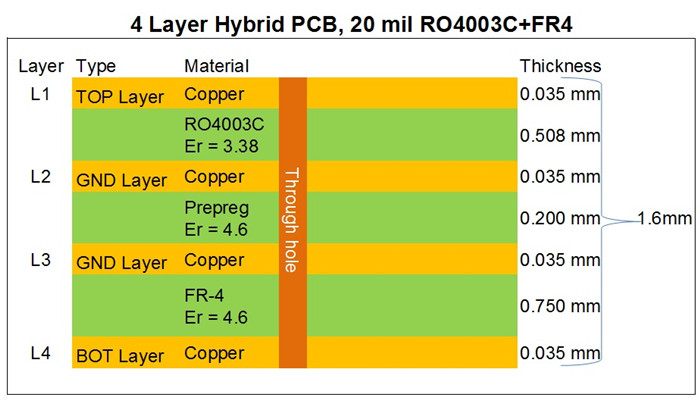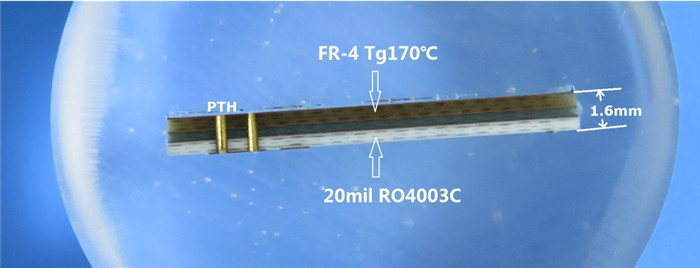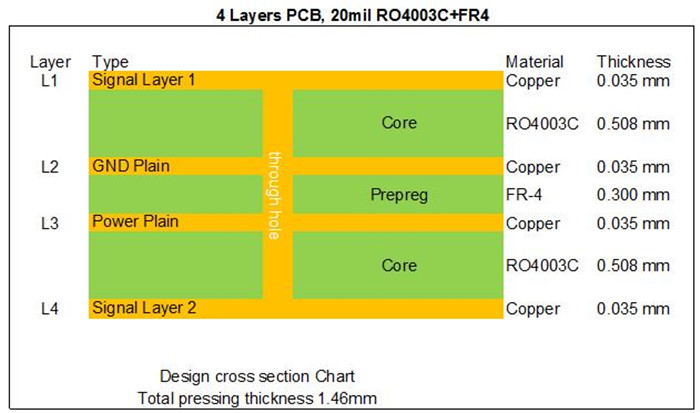Hybrid PCB Board Built on 20mil RO4003C and 0.75mm FR-4 High Frequency Multi-layer PCB with Mixed Materials
(PCBs are custom-made products; the images and parameters shown are for reference only)
Introduction
Hello Everyone,
Warm greetings!
Today, we will discuss a 4-layer hybrid PCB constructed using 20mil RO4003C and FR-4 materials.
This board features a 4-layer structure, which is relatively simple and cost-effective, making it an excellent choice for entering new markets.

Firstly, this PCB features a 4-layer structure. The first two layers consist of a 20mil RO4003C core, which serves as the primary wiring layer for signal lines. The third and fourth layers utilize FR-4 material, with both cores bonded using 0.2mm prepreg. Each layer is interconnected through plated through holes (PTH), and the copper weight on both the inner and outer layers is 1 ounce. This design effectively keeps the board cost-effective.
Let’s take a look at its micro-section chart.

On the left, you can see the PTH hole. The lower section represents layers one and two, composed of high-frequency material, while the upper part consists of glass fiber material. The finished thickness of the board measures 1.6mm.
The solder mask and silkscreen colors typically used are green and white, with immersion gold as the surface finish on the pads.
Next, we present another variant of the 20mil RO4003C hybrid PCB, made entirely from two cores of 20mil RO4003C.

The applications for the 20mil RO4003C hybrid PCB are extensive, including LNA, optical couplers, balanced amplifiers, duplexers, and more.
The advantages of the 20mil RO4003C hybrid PCB are highlighted in the following points:
1)Stable Dielectric Constant: RO4003C maintains a consistent dielectric constant across a wide frequency range, making it an ideal substrate for broadband applications.
2)Reduced Signal Loss: This design minimizes signal loss in high-frequency applications, aligning with the evolving needs of communication technology.
3)Cost Efficiency: Utilizing this hybrid approach can reduce costs compared to stacks made entirely of low-loss materials.
Our PCB Capability (Hybrid Design)
PCB Type: |
Hybrid PCB, Mixed PCB |
Mixed type: |
RO4350B + FR4; |
RO4003C + FR4; |
|
F4B + FR4; |
|
Duroid/RT5880 + RO4350B |
|
Duroid/RT5880 + FR4 |
|
Solder mask: |
Green, Red, Blue, Black, Yellow |
Layer count: |
4 Layer, 6 Layer, Multilayer |
Copper weight: |
0.5oz (17 µm), 1oz (35µm), 2oz (70µm) |
PCB thickness: |
1.0-5.0mm |
PCB size: |
≤400mm X 500mm |
Surface finish: |
Bare copper, HASL, ENIG, Immersion tin, OSP |
We currently offer a range of mature mixed pressing materials, including:
RO4350B + FR4
RO4003C + FR4
F4B + FR4
RT/Duroid 5880 + FR4
RT/Duroid 5880 + RO4350B
Thank you for reading. We welcome your inquiries regarding RF PCBs.
Appendix: Data Sheet of RO4003C
RO4003C Typical Value |
|||||
Property |
RO4003C |
Direction |
Units |
Condition |
Test Method |
Dielectric Constant,εProcess |
3.38±0.05 |
Z |
|
10 GHz/23℃ |
IPC-TM-650 2.5.5.5 Clamped Stripline |
Dielectric Constant,εDesign |
3.55 |
Z |
|
8 to 40 GHz |
Differential Phase Length Method |
Dissipation Factortan,δ |
0.0027 |
Z |
|
10 GHz/23℃ |
IPC-TM-650 2.5.5.5 |
Thermal Coefficient of ε |
+40 |
Z |
ppm/℃ |
-50℃to 150℃ |
IPC-TM-650 2.5.5.5 |
Volume Resistivity |
1.7 x 1010 |
|
MΩ.cm |
COND A |
IPC-TM-650 2.5.17.1 |
Surface Resistivity |
4.2 x 109 |
|
MΩ |
COND A |
IPC-TM-650 2.5.17.1 |
Electrical Strength |
31.2(780) |
Z |
Kv/mm(v/mil) |
0.51mm(0.020") |
IPC-TM-650 2.5.6.2 |
Tensile Modulus |
19,650(2,850) |
X |
MPa(ksi) |
RT |
ASTM D 638 |
Tensile Strength |
139(20.2) |
X |
MPa(ksi) |
RT |
ASTM D 638 |
Flexural Strength |
276 |
|
MPa |
|
IPC-TM-650 2.4.4 |
Dimensional Stability |
<0.3 |
X,Y |
mm/m |
after etch+E2/150℃ |
IPC-TM-650 2.4.39A |
Coefficient of Thermal Expansion |
11 |
X |
ppm/℃ |
-55℃to288℃ |
IPC-TM-650 2.4.41 |
Tg |
>280 |
|
℃ TMA |
A |
IPC-TM-650 2.4.24.3 |
Td |
425 |
|
℃ TGA |
|
ASTM D 3850 |
Thermal Conductivity |
0.71 |
|
W/M/oK |
80℃ |
ASTM C518 |
Moisture Absorption |
0.06 |
|
% |
48hrs immersion 0.060" |
ASTM D 570 |
Density |
1.79 |
|
gm/cm3 |
23℃ |
ASTM D 792 |
Copper Peel Stength |
1.05 |
|
N/mm |
after solder float 1 oz. |
IPC-TM-650 2.4.8 |
Flammability |
N/A |
|
|
|
UL 94 |
Lead-free Process Compatible |
Yes |
|
|
|
|
